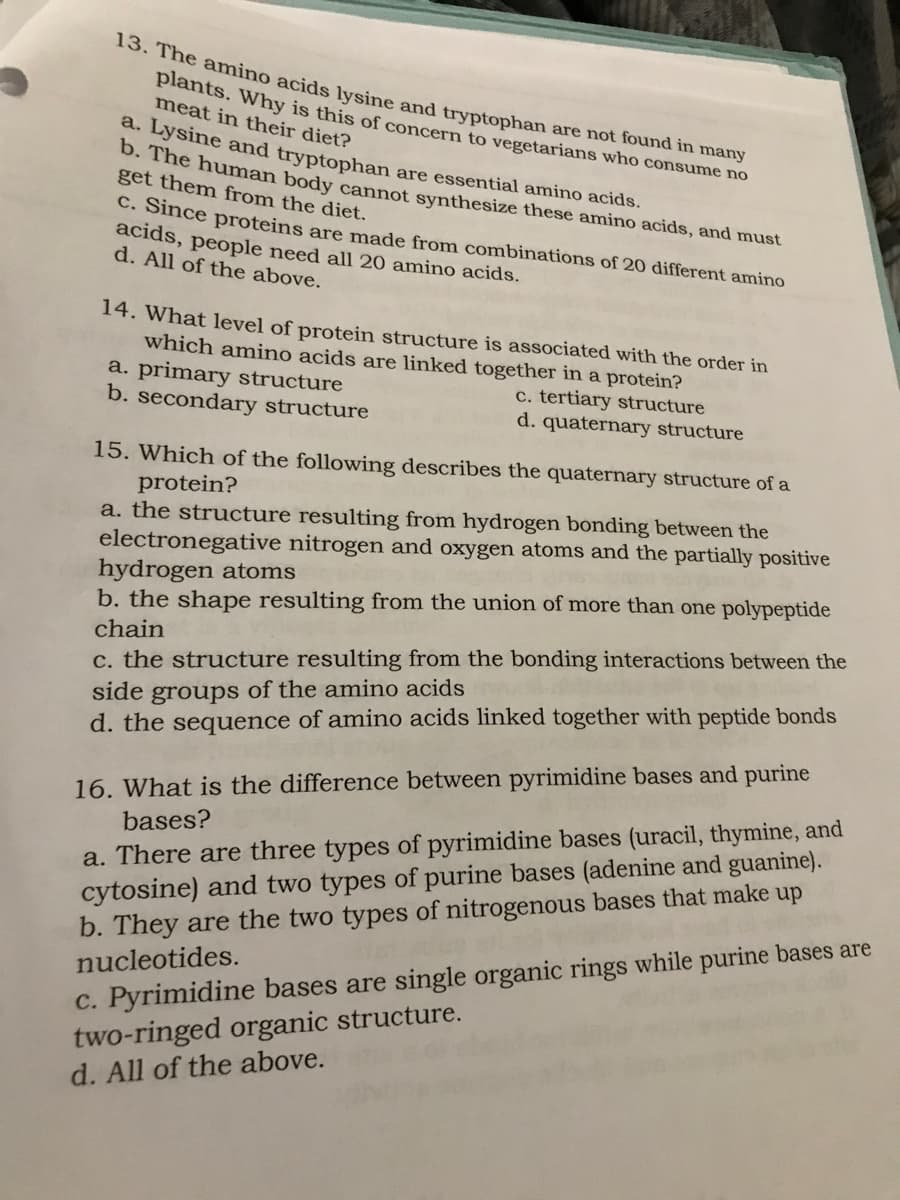13. The amino acids lysine and tryptophan are not found in many plants. Why is this of concern to vegetarians who consume no meat in their diet? a. Lysine and tryptophan are essential amino acids. b. The human body cannot synthesize these amino acids, and must get them from the diet. c. Since proteins are made from combinations of 20 different amino acids, people need all 20 amino acids. d. All of the above. 14. What level of protein structure is associated with the order in which amino acids are linked together in a protein? c. tertiary structure d. quaternary structure a. primary structure b. secondary structure 15. Which of the following describes the quaternary structure of a protein? a. the structure resulting from hydrogen bonding between the electronegative nitrogen and oxygen atoms and the partially positive hydrogen atoms b. the shape resulting from the union of more than one polypeptide chain c. the structure resulting from the bonding interactions between the side groups of the amino acids d. the sequence of amino acids linked together with peptide bonds 16. What is the difference between pyrimidine bases and purine bases? a. There are three types of pyrimidine bases (uracil, thymine, and nd quanine).
13. The amino acids lysine and tryptophan are not found in many plants. Why is this of concern to vegetarians who consume no meat in their diet? a. Lysine and tryptophan are essential amino acids. b. The human body cannot synthesize these amino acids, and must get them from the diet. c. Since proteins are made from combinations of 20 different amino acids, people need all 20 amino acids. d. All of the above. 14. What level of protein structure is associated with the order in which amino acids are linked together in a protein? c. tertiary structure d. quaternary structure a. primary structure b. secondary structure 15. Which of the following describes the quaternary structure of a protein? a. the structure resulting from hydrogen bonding between the electronegative nitrogen and oxygen atoms and the partially positive hydrogen atoms b. the shape resulting from the union of more than one polypeptide chain c. the structure resulting from the bonding interactions between the side groups of the amino acids d. the sequence of amino acids linked together with peptide bonds 16. What is the difference between pyrimidine bases and purine bases? a. There are three types of pyrimidine bases (uracil, thymine, and nd quanine).
Biology: The Dynamic Science (MindTap Course List)
4th Edition
ISBN:9781305389892
Author:Peter J. Russell, Paul E. Hertz, Beverly McMillan
Publisher:Peter J. Russell, Paul E. Hertz, Beverly McMillan
Chapter47: Animal Nutrition
Section: Chapter Questions
Problem 8TYK: The role of the liver in digestion is to: a. synthesize aminopeptidase and dipeptidase to...
Related questions
Question
100%
Please help me understand and answer the following.

Transcribed Image Text:13. The amino acids lysine and tryptophan are not found in many
plants. Why is this of concern to vegetarians who consume no
meat in their diet?
a. Lysine and tryptophan are essential amino acids.
b. The human body cannot synthesize these amino acids, and must
get them from the diet.
c. Since proteins are made from combinations of 20 different amino
acids, people need all 20 amino acids.
d. All of the above.
14. What level of protein structure is associated with the order in
which amino acids are linked together in a protein?
c. tertiary structure
d. quaternary structure
a. primary structure
b. secondary structure
15. Which of the following describes the quaternary structure of a
protein?
a. the structure resulting from hydrogen bonding between the
electronegative nitrogen and oxygen atoms and the partially positive
hydrogen atoms
b. the shape resulting from the union of more than one polypeptide
chain
c. the structure resulting from the bonding interactions between the
side groups of the amino acids
d. the sequence of amino acids linked together with peptide bonds
16. What is the difference between pyrimidine bases and purine
bases?
a. There are three types of pyrimidine bases (uracil, thymine, and
cytosine) and two types of purine bases (adenine and guanine).
b. They are the two types of nitrogenous bases that make up
nucleotides.
c. Pyrimidine bases are single organic rings while purine bases are
two-ringed organic structure.
d. All of the above.
Expert Solution
This question has been solved!
Explore an expertly crafted, step-by-step solution for a thorough understanding of key concepts.
Step by step
Solved in 4 steps

Knowledge Booster
Learn more about
Need a deep-dive on the concept behind this application? Look no further. Learn more about this topic, biology and related others by exploring similar questions and additional content below.Recommended textbooks for you

Biology: The Dynamic Science (MindTap Course List)
Biology
ISBN:
9781305389892
Author:
Peter J. Russell, Paul E. Hertz, Beverly McMillan
Publisher:
Cengage Learning

Nutrition: Concepts and Controversies - Standalo…
Health & Nutrition
ISBN:
9781305627994
Author:
Frances Sizer, Ellie Whitney
Publisher:
Brooks Cole

Biology: The Unity and Diversity of Life (MindTap…
Biology
ISBN:
9781305073951
Author:
Cecie Starr, Ralph Taggart, Christine Evers, Lisa Starr
Publisher:
Cengage Learning

Biology: The Dynamic Science (MindTap Course List)
Biology
ISBN:
9781305389892
Author:
Peter J. Russell, Paul E. Hertz, Beverly McMillan
Publisher:
Cengage Learning

Nutrition: Concepts and Controversies - Standalo…
Health & Nutrition
ISBN:
9781305627994
Author:
Frances Sizer, Ellie Whitney
Publisher:
Brooks Cole

Biology: The Unity and Diversity of Life (MindTap…
Biology
ISBN:
9781305073951
Author:
Cecie Starr, Ralph Taggart, Christine Evers, Lisa Starr
Publisher:
Cengage Learning